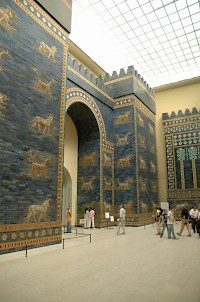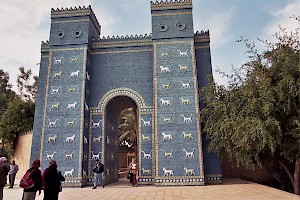Babylon, Ishtar Gate
Q26082Walls of Babylon and Ištar Gate: two famous monuments in Babylon, belonging to the Seven Wonders of the Ancient World.

The walls of Babylon owe their fame to the Greek researcher Herodotus of Halicarnassus (fifth century BCE). He says:
Babylon lies in a great plain, and in size it is such that each face measures 22½ km, the shape of the whole being square; thus the circumference is 90 km. Such is the size of the city of Babylon, and it has a magnificence greater than all other cities of which we have knowledge. First there runs round it a deep and broad trench, full of water; then a wall fifty meters in thickness and hundred meters in height [...]. At the top of the wall along the edges they built chambers of one story facing one another; and between the rows of chambers they left space to drive a four-horse chariot. In the circuit of the wall there are set a hundred gates made of bronze.note

This would have been a very splendid wall indeed, but it is easy to see that the dimensions are vastly exaggerated. The real circumference is 8,400 meters and the hundred gates are an obvious reference to Homer's description of Egyptian Thebes; in fact, Babylon had eight gates, including the splendid Ištar Gate.
Although several scholars, like Babylon's excavator Robert Koldewey, have tried to harmonize the written sources and the archaeological finds, it is now generally agreed that Herodotus never visited Babylon, and that his description is based on hearsay.